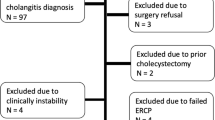Summary
The purpose of this study was to evaluate the indications and results of endoscopic retrograde cholangiopancreatography (ERCP) for gallstone disease since the advent of laparoscopic cholecystectomy. In our personal series of 410 consecutive cases of laparoscopic cholecystectomy, we found 17 common bile duct (CBD) stones; seven were identified by preop ERCP, nine at laparoscopy by intraoperative cholangiography, and one postop by ERCP. We have performed preop ERCP in 21 patients (5.1%); CBD stones were found in seven. Our indications for preop ERCP were elevated liver function tests, dilatation of the common duct by ultrasound, or a history of jaundice/pancreatitis, and all stones were successfully removed by endoscopic sphincterotomy. At laparoscopic cholecystectomy nine patients were found to have stones; one was treated with laparoscopic methods, four with open CBD exploration, and four by postop endoscopic sphincterotomy. Post-laparoscopic cholecystectomy, five patients underwent ERCP for pain or increased liver function tests suggestive of common duct stones. One of the five was found to have stones and these were successfully removed by endoscopic sphincterotomy. ERCP is very useful as a diagnostic and therapeutic modality in laparoscopic cholecystectomy patients with suspected CBD stones. Elevated liver function tests and dilated CBD by ultrasound are the most accurate predictors of stones. Endoscopic sphincterotomy is a more effective route, at present, for stone removal than a laparoscopic approach.
Similar content being viewed by others
References
Arregui ME, Davis CJ, Arkush AM, Nagan RF (1992) Laparoscopic cholecystectomy combined with endoscopic sphincterotomy and stone extraction or laparoscopic choledochoscopy and electrohydraulic lithotripsy for management of cholelithiasis with choledocholithiasis. Surg Endosc 6: 10–15
Cotton PB, Baillie MB, Pappas TN, Meyers WS (1991) Laparoscopic cholecystectomy and the biliary endoscopist. Gastrointest Endosc 37: 94–96
Hansell DT, Millar MA, Murray WR, Gray GR, Gillespie G (1989) Endoscopic sphincterotomy for bile duct stones in patients with intact gallbladders. Br J Surg 76: 856–858
Kullman E, Borch K, Liedberg G (1989) Long-term follow-up after endoscopic management of retained and recurrent common duct stones. Acta Chir Scand 155: 395–399
Larson GM, Vitale GC, Casey J, Evans JS, Gilliam G, Heuser L, McGee G, Rao M, Scherm MJ, Voyles R (1991) Multipractice analysis of laparoscopic cholecystectomy in 1,983 patients. Am J Surg 163: 221–226
Liguory C, Lefebvre JF, Bonnel D, Vitale GC (1991) Cutting the difficult papilla: Ancillary techniques in the performance of endoscopic sphincterotomy. Can J Gastroenterol 4: 564–567
Author information
Authors and Affiliations
Rights and permissions
About this article
Cite this article
Vitale, G.C., Larson, G.M., Wieman, T.J. et al. The use of ERCP in the management of common bile duct stones in patients undergoing laparoscopic cholecystectomy. Surg Endosc 7, 9–11 (1993). https://doi.org/10.1007/BF00591228
Issue Date:
DOI: https://doi.org/10.1007/BF00591228




